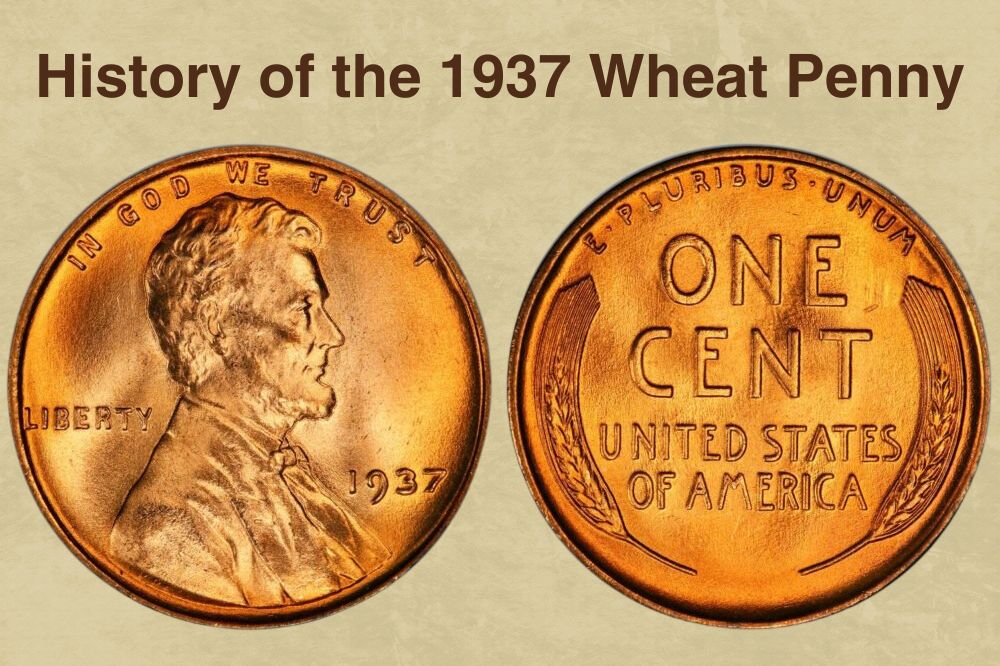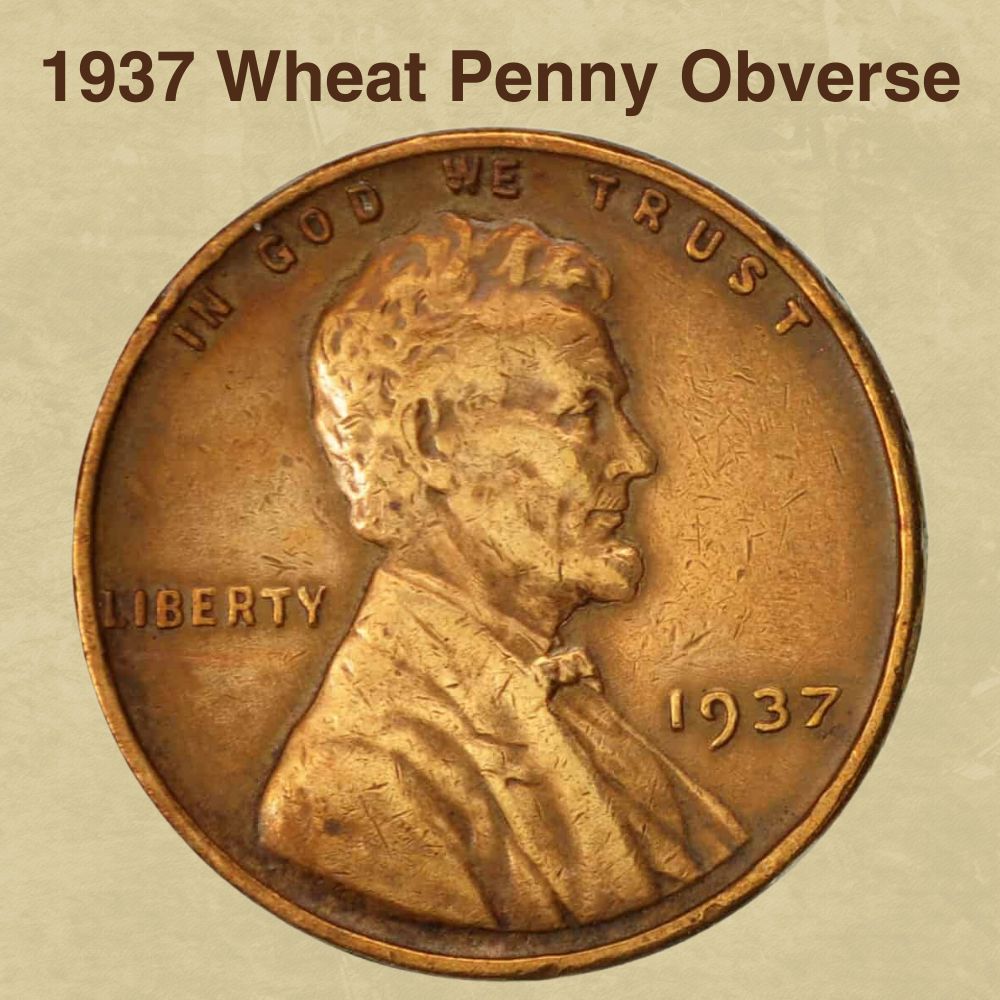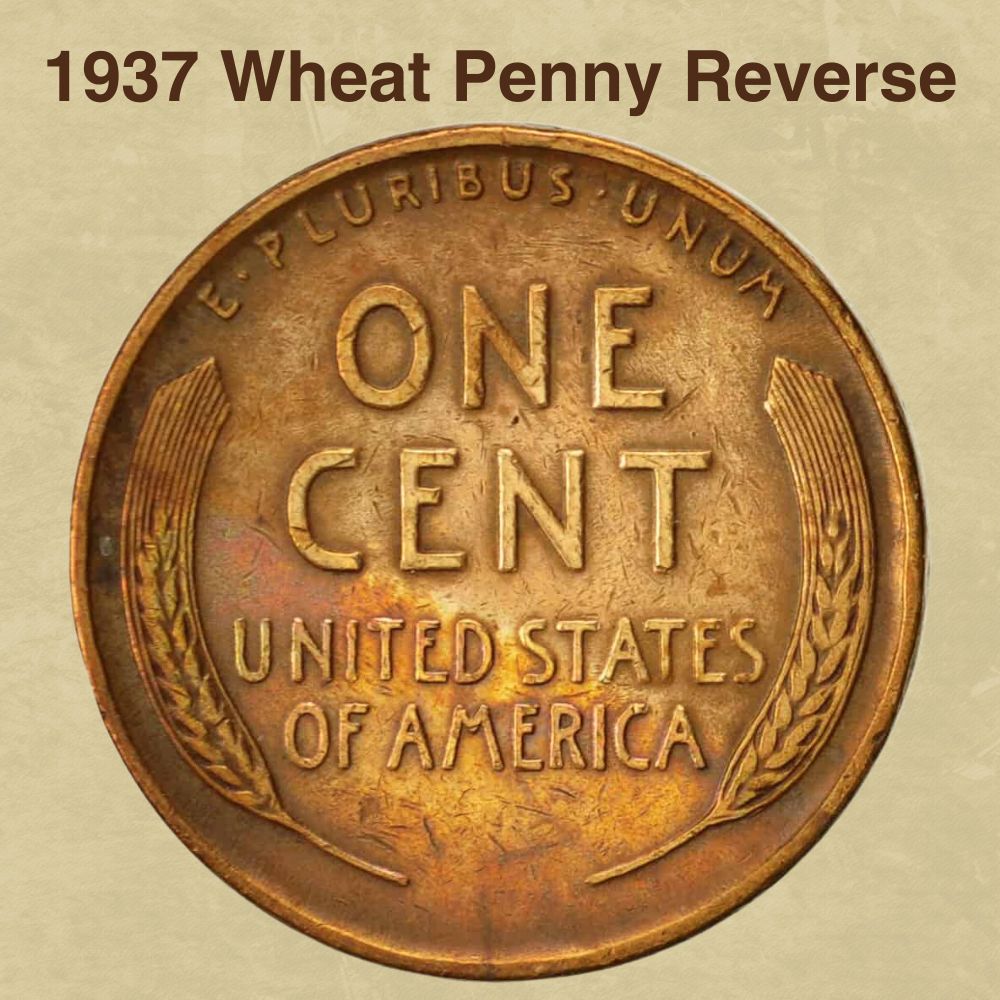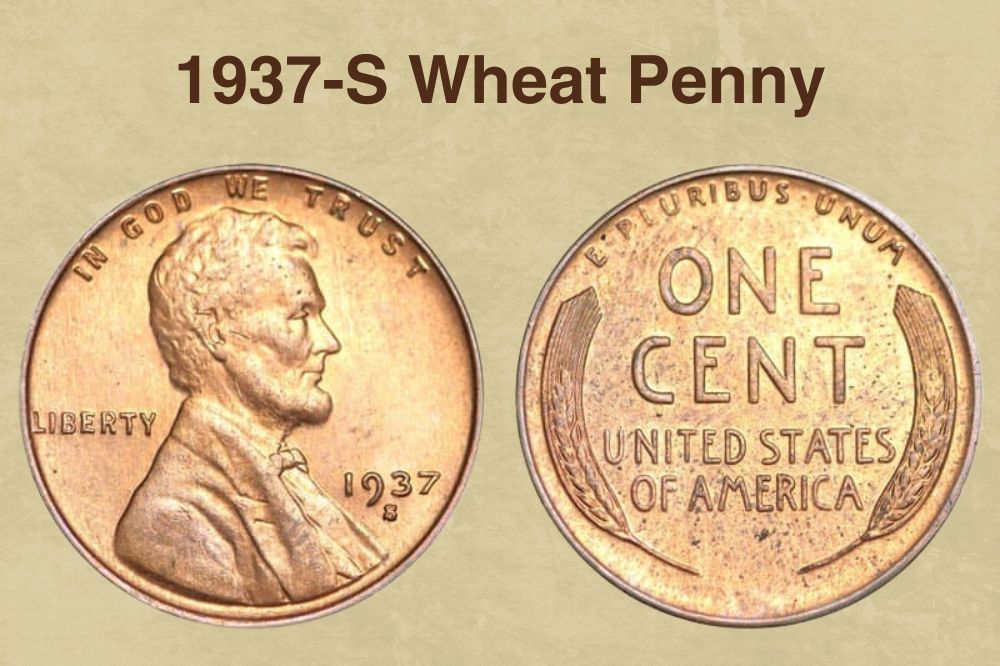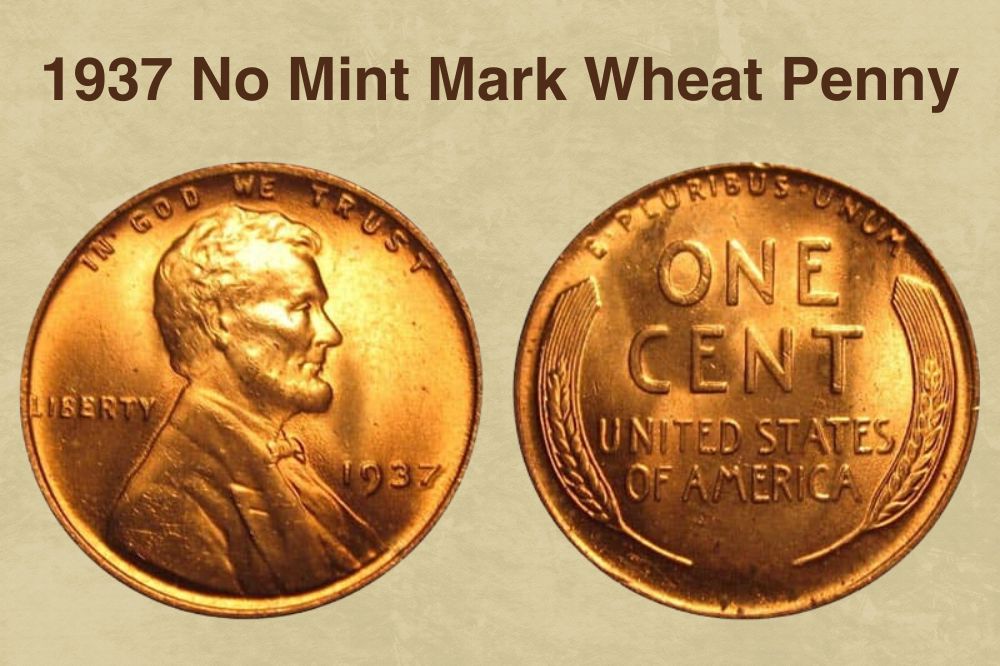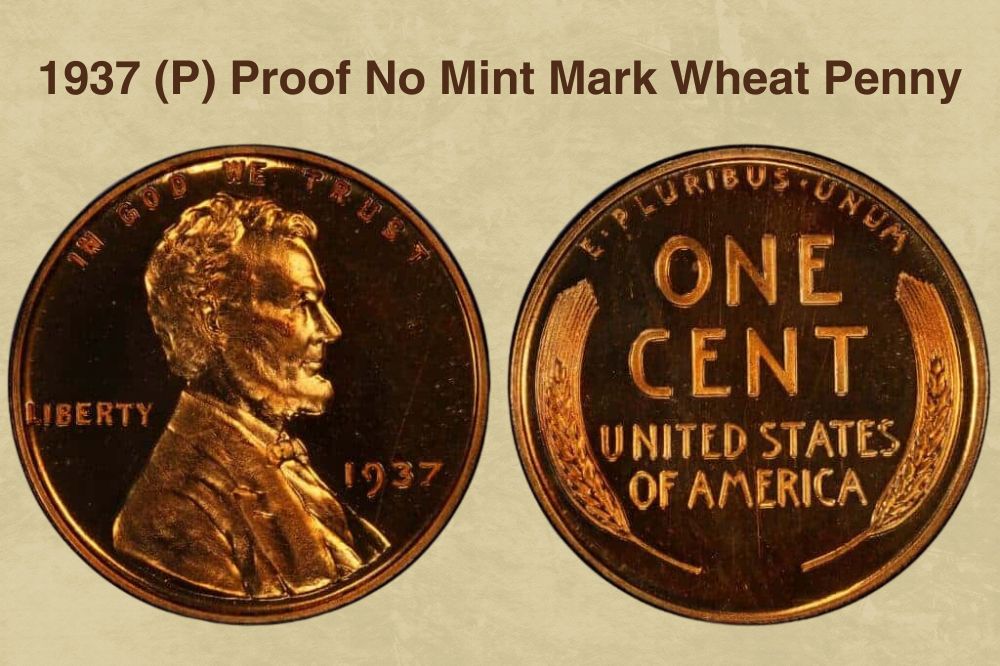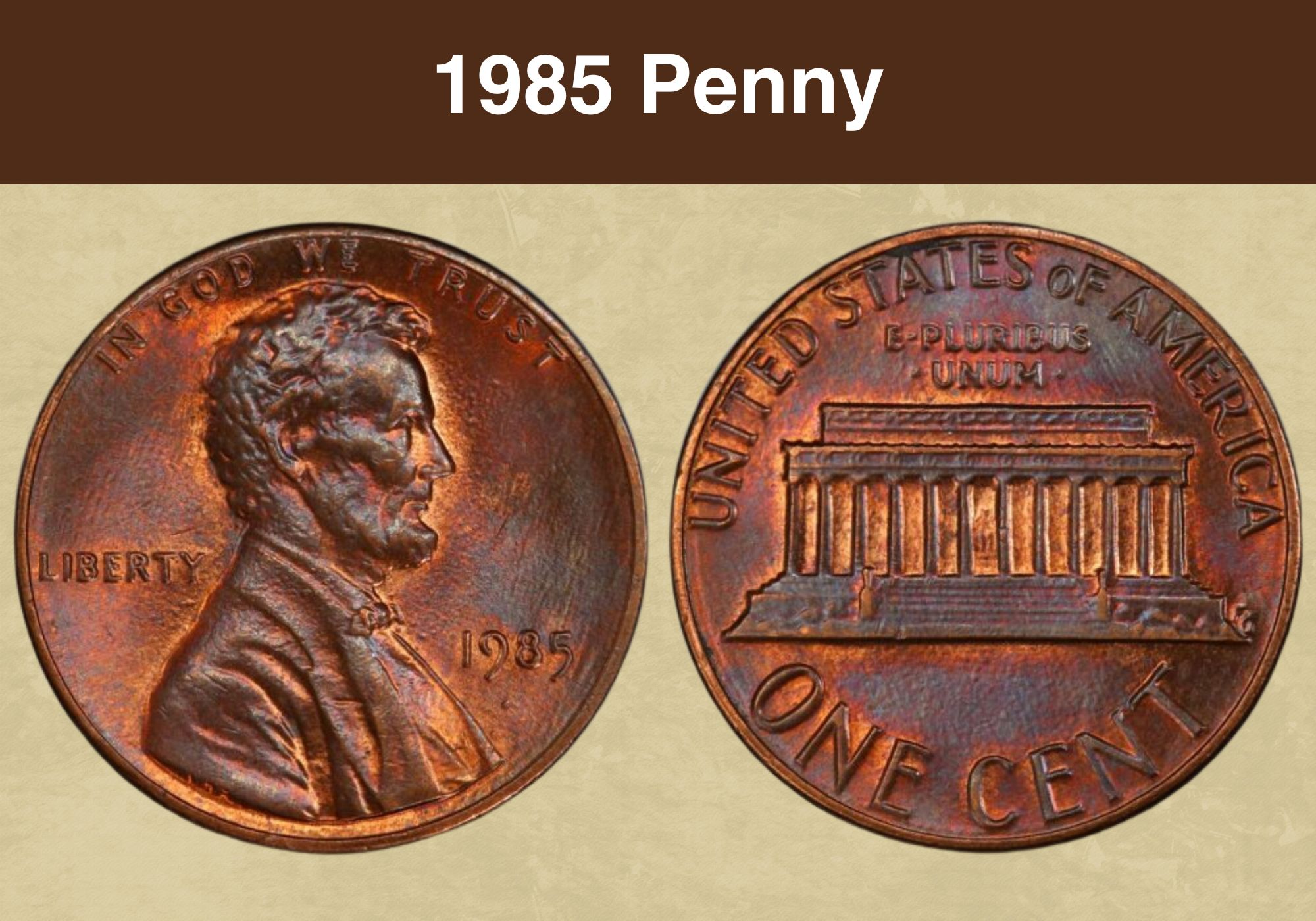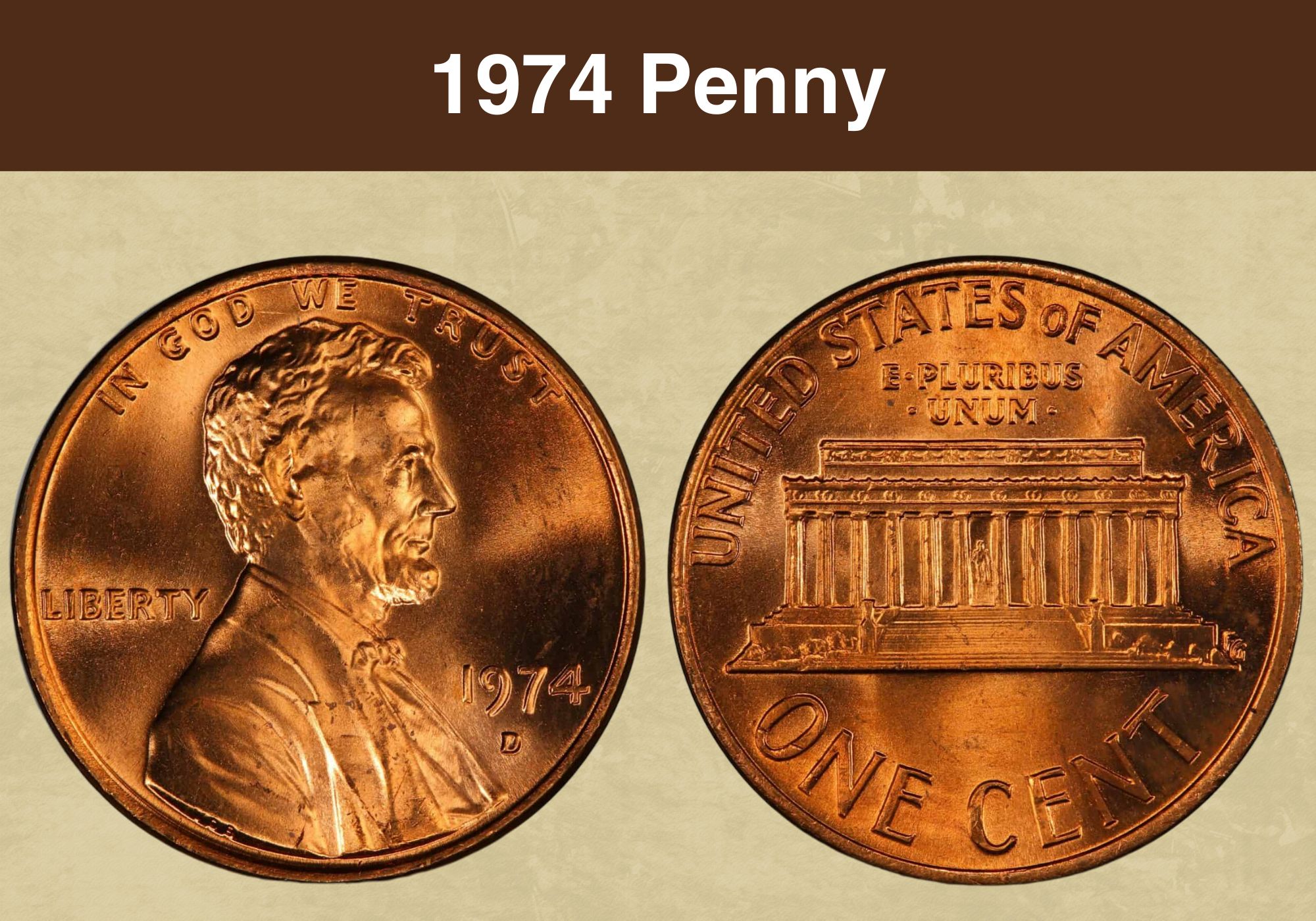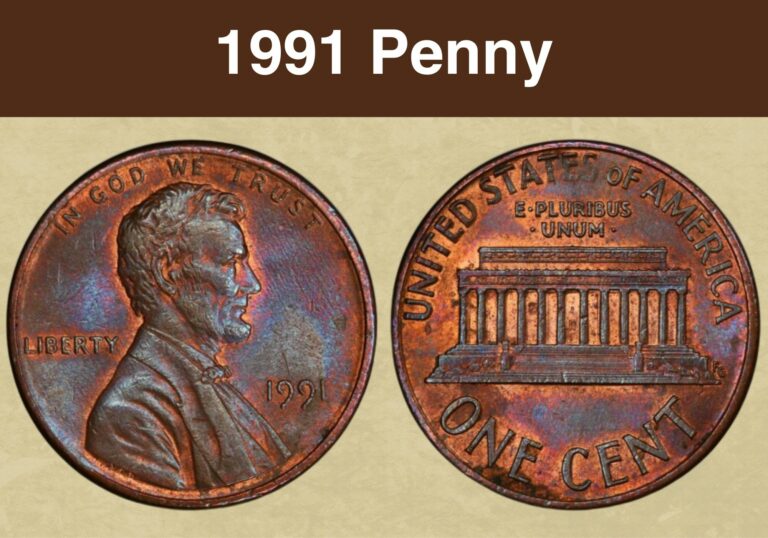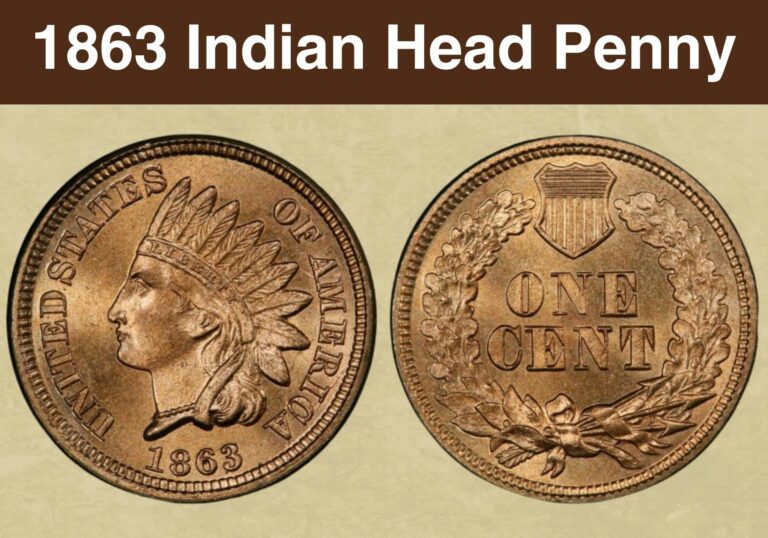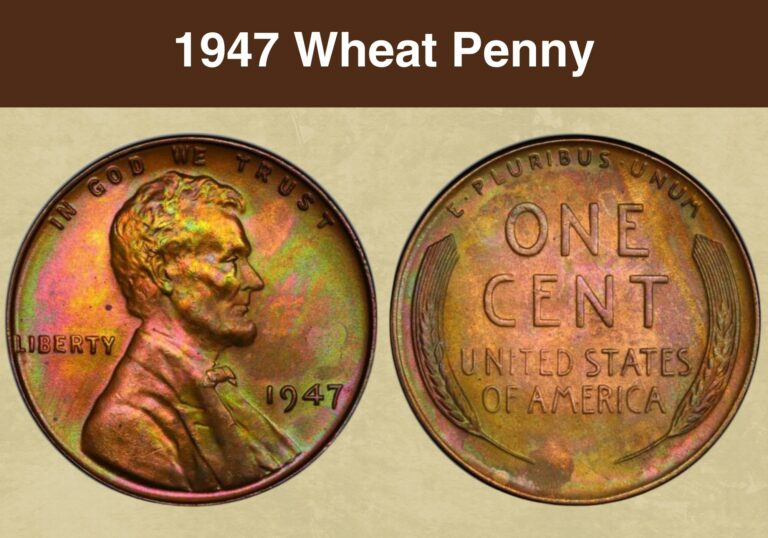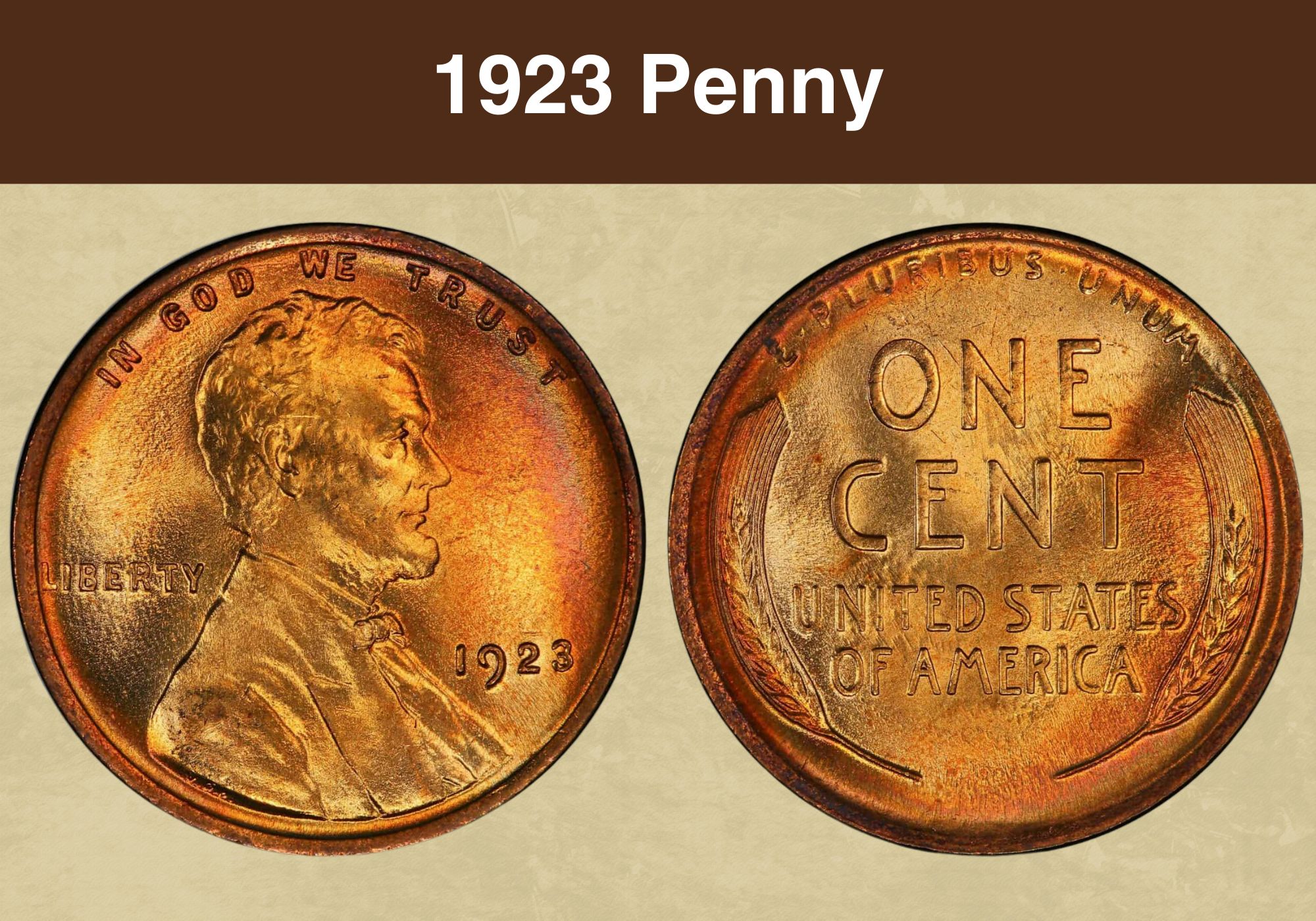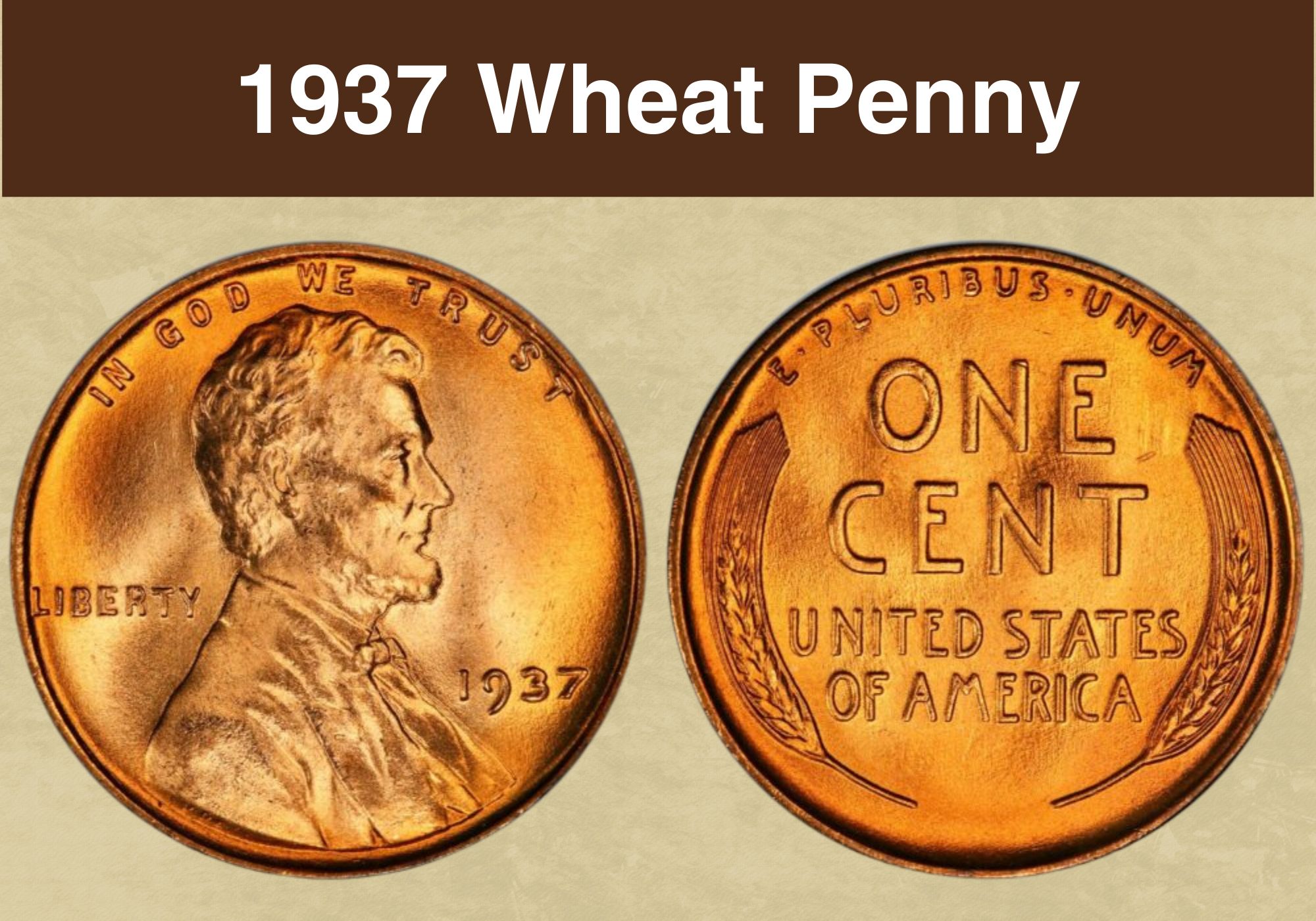
Coin Value Contents Table
- 1937 Circulating Wheat Penny Value Chart
- 1937 Proof Wheat Penny Value Chart
- History of the 1937 Wheat Penny
- Features of the 1937 Wheat Penny
- 1937 Wheat Penny Grading
- 1937 Wheat Penny Value Guides
- 1937-D Wheat Penny Value
- 1937-S Wheat Penny Value
- 1937 No Mint Mark Wheat Penny Value
- 1937 (P) Proof No Mint Mark Wheat Penny Value
- Rare 1937 Wheat Penny Errors List
- Where to Sell Your 1937 wheat penny ?
- 1937 Wheat Penny FAQ
The Wheat Penny is the first variant of the Lincoln Penny, and it gets its name from the wheat stalks on the back of the coin. Also, 1937 was the year they re-introduced mirror-like proofs after playing with Satin Finish proofs in 1936. It’s an important milestone for proof collectors. Let’s look at the 1937 Wheat Penny Value and learn the relevant facts around it.
1937 Circulating Wheat Penny Value Chart |
||||||
| Coin | MS 60 | MS 62+ | MS 64+ | MS 66+ | MS 67+ | MS 68 |
| 1937-D Wheat Penny | $6 | $9 | $22 | $55 | $650 | $13,000 |
| 1937-S Wheat Penny | $5 | $8 | $24 | $100 | $1,450 | $22,500 |
| 1937 (P) No Mint Mark Wheat Penny | $4 | $7 | $22 | $60 | $775 | $15,500 |
1937 Proof Wheat Penny Value Chart |
||||||
| Coin | PR/PF 58 | PR/PF 60 | PR/PF 62 | PR/PF 63+ | PR/PF 65 | PR/PF 67 |
| 1937 (P) Proof No Mint Mark Wheat Penny Brown | $12 | $22 | $34 | $95 | $185 | – |
| 1937 (P) Proof No Mint Mark Wheat Penny Red-Brown | – | $40 | $80 | $135 | $200 | $800 |
| 1937 (P) Proof No Mint Mark Wheat Penny Red | – | $50 | $100 | $225 | $450 | $3,250 |
| 1937 (P) Proof No Mint Mark Wheat Penny Cameo | – | $100 | $185 | $375 | $1,050 | $15,000 |
| 1937 (P) Proof No Mint Mark Wheat Penny Deep Cameo | – | – | – | – | $4,500 | – |
History of the 1937 Wheat Penny
The art of making coins has two pathways. One is the casting system, where medals and hard currency use molten metal and molds. In such cases, the design has to be super simple. This style was popular in Great Britain during colonial times. The other is hand-carved items like buttons and brooches. It was the preferred option in countries like France, Italy, and Spain.
The latter method was more artistic and sculptural, which made it more aesthetic. This also made it more expensive and less suitable for mass production. And these ideas clashed when Theodore Roosevelt – the 26th US President – commissioned external artists to work on coins. He wanted American currency to be pretty, like coins from Ancient Rome and Greece.
However since the current engravers at the US Mint were trained as medal tradesmen, they were more into low-key designs with minimal relief. Conversely, the sculptor recommended by the president was Augustus Saint-Gaudens, a 3D artist from the French school of thought. But he was ill and died before completing the coin beautification program that started in 1904.
Teddy Roosevelt and the Prettification of American Coins
In 1909, the Lincoln Wheat Penny (aka the Lincoln Wheat Cent) was completed by Victor David Brenner. He was one of Saint-Gaudens’ assistants so he was a natural choice for the President and was equally unwelcome among mint workers. The two factions clashed all through the process but in the end, they produced a coin so beloved that we still use it today.
In olden times, copper was way cheaper than silver and gold so it was a profitable coin for the mint. This is because a coin was expected to carry its equivalent weight in metal. So when copper spot prices shot up in the 1850s (as a result of the gold rush), the mint had to make pennies smaller so that their weight would match their market value. Later, things changed.
From Melt Value to Face Value
Once coins became fiduciary – meaning they got their value from law rather than melt price – the mint could make a profit on coins. The difference between the cost price and face value was known as seignorage, and it became a sort of tax that raised revenue for the government. The goal is to keep it as low as possible, and that’s a big problem in minting US coins today.
It costs almost 3c to mint a single penny and 11 cents to make one nickel. This means the coins use up more money than they’re worth, causing losses at the mint. But despite efforts by various financial lobbyists, we love our pennies and will continue to mint them. In 2021, President Trump signed a bill that will keep the Lincoln Cent circulating until at least 2026.
Also read: 12 Most Valuable Lincoln Penny Worth Money
Features of the 1937 Wheat Penny
When you’re describing the features of a coin, you should refer to the heads side as the obverse, the tails side as the reverse, the thin side as the edge, the raised border as the rim or collar, the images as devices, and the backdrop as the field. The words are legends or mottos.
The Obverse of the 1937 Wheat Penny
It shows Abraham Lincoln, the 16th US President. He’s facing right, with In God We Trust above his head, Liberty on his left, and the mint date on his right. The mint mark is under the mint date. His shoulder cut-off has VDB for the coin designer, Victor David Brenner.
The Reverse of the 1937 Wheat Penny
It shows two ears of wheat framing the sides of the coin. At the top of the coin, between the wheat sheaves, it says E Pluribus Unum in a medium-sized font. The middle of the coin bears the denomination, One Cent, while the bottom names our country, United States of America.
Other Features of the 1937 Wheat Penny
The 1937 Wheat Penny was 95% copper with the remaining 5% in either zinc or tin, though the two metals were sometimes mixed. It has a smooth or plain edge (i.e. no reeds), weighs 3.11g, and is 19.05mm in diameter (0.75”). It’s color-graded as red, red-brown, or brown.
Also read: 13 Most Valuable Wheat Penny Worth Money
1937 Wheat Penny Grading
Earlier, we mentioned the color grades of pennies, but we didn’t list their codes as used by appraisal companies like ANACS (American Numismatic Association Certification Service), NGC (Numismatic Guaranty Company/Corporation), and PCGS (Professional Coin Grading Service). They use RD for red (highest grade), RB for red-brown, and BN or BRN for brown.
| # | Grade |
|---|---|
| 1 | Basal State-1 |
| 2 | Fair |
| 3 | Very Fair |
| 4, 5, 6 | Good |
| 7, 8, 10 | Very Good |
| 12, 15 | Fine |
| 20, 30 | Very Fine |
| 40 | Extremely Fine |
| 50 | About Uncirculated |
| 60 | Mint State |
| 65 | Mint State |
| 70 | Mint State |
Please check our grading guides to know your coin scale, It’s the necessary step to know the exact value of your coin.
Check out now: How to Grade Lincoln Wheat Penny?
1937 Wheat Penny Value Guides
In 1937, Lincoln Wheat Pennies were coined in Philadelphia, Denver, and San Francisco. Back then, proofs were still being made in Philadelphia. But you might find circulating coins that resemble proofs. They’re graded PL for proof-like or DMPL for deep-mirror-proof-like. You’ll also see Deep Cameo or DCAM for proof coins with the strongest field-device contrast.
1937-D Wheat Penny Value
In 1937, the Denver Mint made 50,430,000 Wheat Pennies with the D Mint Mark. They were business strikes or regular strikes, which means they were intended for everyday use. A coin graded Uncirculated Details BN (meaning it was damaged) sold for $295 on eBay in 2021. An MS 65 RB was $204 the same year. But an MS 68 RD was $17,250 in 2006 and 11 exist.
1937-S Wheat Penny Value
The San Francisco Mint made 34,500,000 Wheat Pennies in 1937. They were all business strikes and had the S Mint Mark. On eBay, an MS 65 BN was $130 in 2018 and a Genuine RB graded by NGC was $123 in 2023. But Heritage sold an MS 67+ RD for $2,350 in 2014. Since almost 50 have since shown up, they’re worth $1,450 in 2024, but an MS 68 RD is $22,500!
1937 No Mint Mark Wheat Penny Value
In 1937, the Philadelphia Mint made both proof coins and business strikes. None of them had any mint marks. The regular strike coins were 309,170,000. They’re not especially pricy. In August 2001, an AU 55 BN sold for $690 while an MS 64 RB was $1,495 in March of that same year. But an MS 68 RD was $7,200 in June 2019 and is worth $15,500 now.
1937 (P) Proof No Mint Mark Wheat Penny Value
The Lincoln Wheat Penny was first produced in 1909. At the time, proof coins were matte, which meant their dies were sandblasted to create that hazy texture. This was necessary since Lincoln Cents had a curved surface that didn’t work well as mirror-like proofs. The dies couldn’t be pre-polished so the mint used the same regular strike dies as circulating pennies.
But to ensure clarity, they hand-picked the best dies from the set, applied extra pressure when striking blanks, and used the matte-proof dies for a much shorter period before they were replaced. The matte proofs were also packaged in special sulphur-infused tissue paper. The mint made matte-proof pennies from 1909 to 1917 then stopped making any proof coins.
When they resumed producing proof coins in 1936, they experimented with both mirror-like proofs and satin-finish proofs aka matte proofs. The brilliant proofs had their own special proof dies that were scrubbed with horsehair brushes for extra shine then pickled in acid (or later textured with computerized lasers) to create a frosted finish on the devices and words.
Types and Values of 1937 Proof Pennies
On coins that were textured through acid pickling, the shine would fade over time. Each time the die struck a blank – aka a planchet – the contrast between the field and the device would fade a little. This means the first 50 to 100 coins were graded Ultra Cameo by NGC or Deep Cameo (DCAM) by PCGS. Next came Cameos. In 1937, the mint made 9,320 in Philadelphia.
An eBay vendor sold a PR 67 BN for $2,853 in January 2023. Heritage sold a PR 64 RB for $4,094 in May 2004 but PCGS has close to 100 in this grade so they place it at just $160 in August 2023. The highest grade they’ve seen is PR 67 RB and they only have one so they rate it at $800 though with five samples in PR 66 RB, those are priced at $350 in August 2023.
A PR 68 RD sold for $13,800 in 2018. Half a step down, PCGS has graded three pennies as PR 67+ RD and priced them at $13,500 in 2023. Meanwhile, a PR 67 CAM sold for $24,675 in 2019. With a population of 6 coins, PCGS places them at $15,000 in 2023. One PR 67 DCAM was $13,225 in 2009 but dropped to $12,600 in 2019 and further down to $6,900 in 2020.
Also read: 17 Most Valuable Indian Head Penny Worth Money
Rare 1937 Wheat Penny Errors List
Mint errors can add to the value of any coin. Especially if it’s a First Strike Error, meaning it was caught, confirmed, and certified within 30 days of the coin’s original release. These will have an FS number. But other mint mistakes can be worth money too. Let’s identify a few.
1937 (P) Penny Obverse Struck Through Fragment
Sometimes, a foreign object slips between the die and the blank. The object itself might fuse to the coin or it may fall off and leave a trace of its existence. It’s called a strike through or struck thru, and in this case, the contaminant was a metal shard that left a dent on Lincoln’s face. Graded MS 63 BN, this coin sold for $515. It would cost much more in a higher grade.
1937 (P) Penny Struck 15% Off-Center
Ideally, the planchet needs to be dead center between the dies for the design to come out correctly. But sometimes, the blank is in the wrong position so only part of its surface gets the imprint, leaving the rest of the coin unmarked. That’s called an off-center error and the misalignment is described in percentages. Graded MS 64 RB, this 15% off-center was $145.
1937 (P) Penny Broadstruck
The rim of a coin serves multiple purposes. It helps maintain its shape, thickness, and the consistency of its face value by ensuring it has an equal amount of metal. It also allows the coins to stack. But sometimes, the rim is damaged during minting aka broadstrike, leaving it flatter and thinner in the ruined section. Graded MS 66 BN, this penny sold for over $285.
Also read: 11 Most Valuable Wheat Penny Errors
Where to Sell Your 1937 wheat penny ?
Now that you know the value of your coins, do you know where to sell those coins online easily? Don’t worry, I’ve compiled a list of these sites, including their introduction, pros, and cons.
Check out now: Best Places To Sell Coins Online (Pros & Cons)
1937 Wheat Penny FAQ
Why is the 1937 Penny Rare?
It’s not. You might consider 1937 Proof Pennies rare because they were the first mirror-like proof pennies since 1908. Before that, the mint made mirror-like proofs for the Indian Head Penny, but once Lincoln Cents showed up, they switched to matte proofs aka satin finish coins from 1909 to 1917. They then made no proofs at all until 1935, then in 1936, they made about 5.5K matte proofs and at least one brilliant proof. Then in 1937, they made almost 10K.

